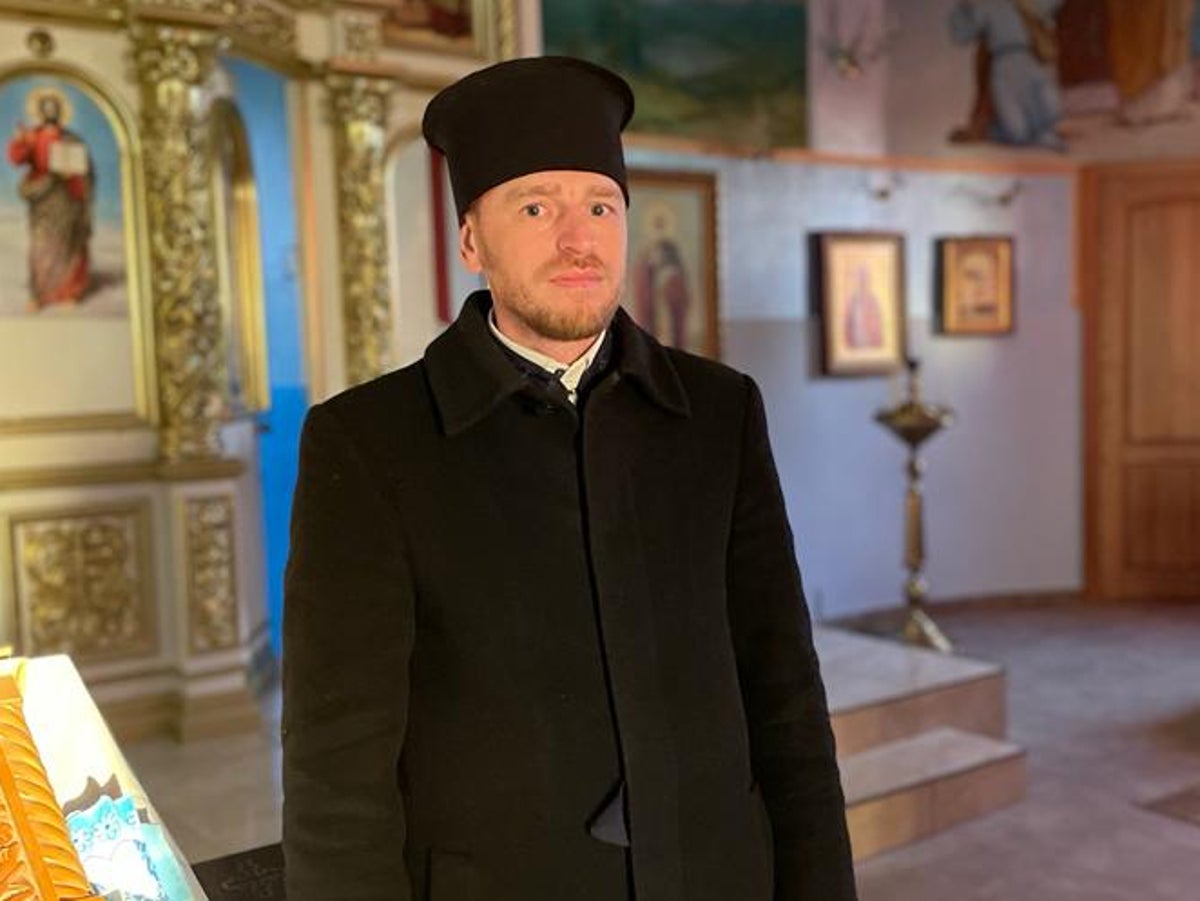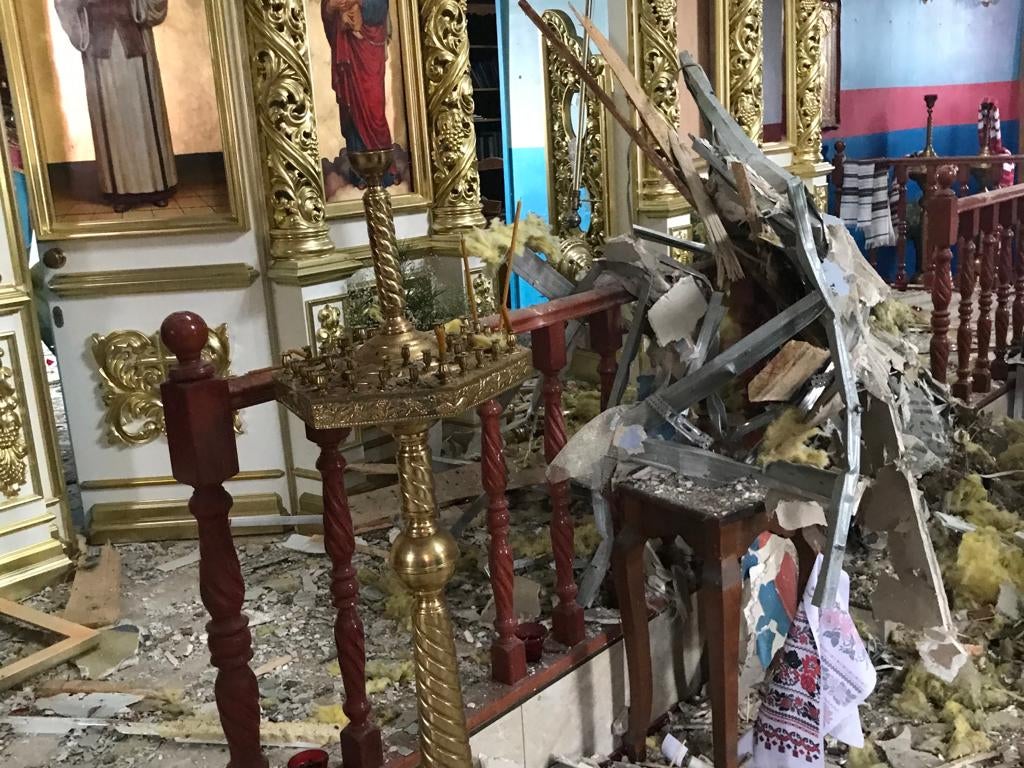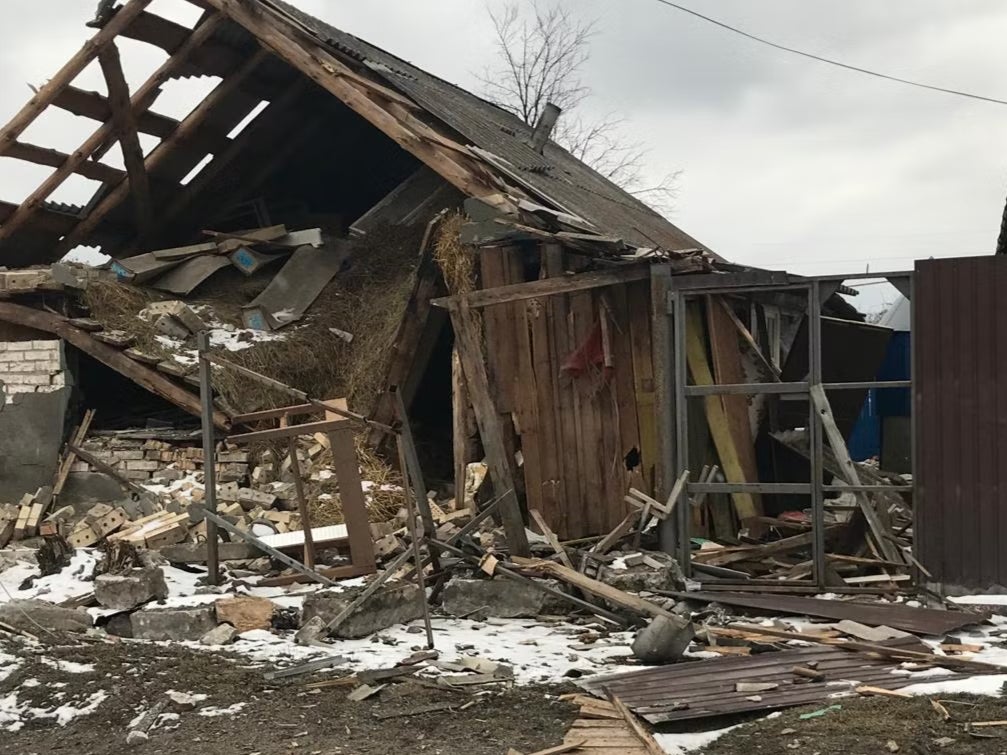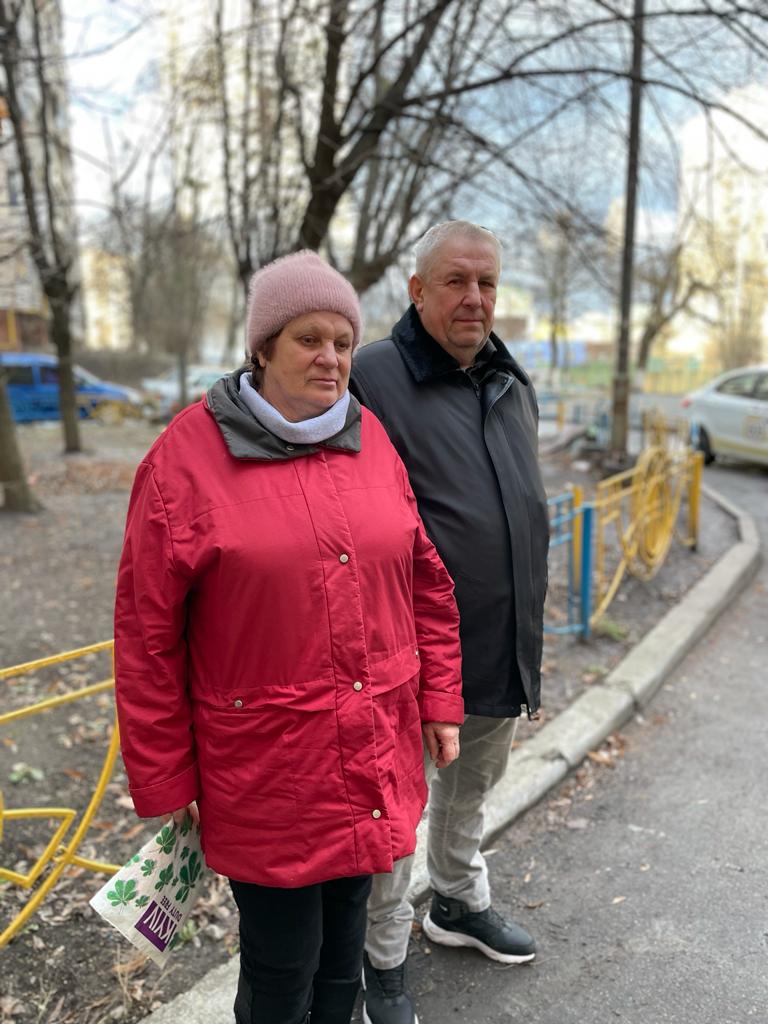
In the early days of the war, with Russian forces closing in on Kyiv, fierce battles erupted in the towns and villages around the capital as Ukraine fought for its existence in the face of Vladimir Putin’s invasion.
One of the most violent arenas was the town of Makariv, filled with streets of shattered houses and twisted, burnt-out cars. It was a desolate landscape of rubble, broken glass and acrid smoke rising from pools of flames. Most residents had fled, the bodies of some who remained lay on the streets.
The areas around Makariv also suffered greatly; nothing seemed sacrosanct. Among the places severely damaged was the Russian Orthodox Church of St Michael’s in Yasnohorodska, where I found Father Roman trying to salvage what he could from the severe damage inflicted by missile strikes.
The priest was outside in the garden when the attack came, and he had to fling himself on the ground. “This is a terrible thing to have happened to a house of God, it is so sad” he said looking at the shattered altar, charred nave and broken cupola. “There is so much aggression now, so much division in our country.”
The Independent reported on what happened to the church – there were offers of donation internationally to repair it. Father Roman stayed on at his tiny rectory, living there without electricity or water, despite repeated pleas from his family to leave for a safer place. He did not want to abandon his few remaining parishioners – mainly elderly people who depended on him, he said.
I met him a few weeks later when Makariv was recaptured by the Ukrainians. He was organising repairs. There was an eruption of shelling as we spoke: “They are outgoing, I have learned to tell the difference now you see, I am not afraid,” he said. It was time to look ahead: “I am hoping that people who have left because of the fighting would start coming back to their homes now. Easter is a time of rebirth, of course, it will be a good time to get our community back together and then move on with the future.”

But it was not to be. As the war approaches its first anniversary, Father Roman is no longer there, he has been replaced as the priest of St Michael’s. It is no longer a Russian Orthodox church, but rather a Ukrainian Orthodox one.
What has happened is the result of a major schism between the two orthodox churches, as well as the deep divisions in society brought about by the war. In Yasnohorodska, the brutality included the killings of civilians including a popular Ukrainian Orthodox priest by Russian troops.
In May last year the Ukrainian Church, in a historic move, formally severed links with the hierarchy in Moscow with the Council of Ukrainian Orthodoxy protesting against the support for the invasion by Patriarch Kirill, the head of both churches. Patriarch Kirill had blessed, in many ceremonies, Russian soldiers going to Ukraine. He said in one sermon “sacrifice in the course of carrying out your military duty washes away all sins...”
Pope Francis warned him against becoming “Putin’s altar boy”. But Patriarch Kirill continued with his incendiary rhetoric. When President Putin ordered military mobilisation last September, Patriarch Kirill warned that “danger looms for Ukrainian people” who are being turned from being "part of the holy united Rus into a state hostile to this Rus, hostile to Russia.”

The rupture between the two churches exacerbated community divisions and has become a political football in a part of the world where orthodox Christianity has become a binding symbol of statehood.
Two months ago, Ukraine's president Volodymyr Zelenskyi announced that his government would stop “religious organisations affiliated with centres of influence in the Russian Federation” from operating in the country for the sake of Ukraine’s “spiritual independence”.
The Ukrainian security services had already started raiding Russian Orthodox Churches and religious institutions, as well as the homes of priests, carrying out 350 searches in one month – last November – alone. The authorities claimed to have found, among other things, illicit hoards of money, false documents, propaganda literature and “evidence of secret early morning prayers for Russia”. Several bishops have been charged with inciting ethnic hatred and spreading propaganda in support of the “Russian world”.
The complex relationship between the two Orthodox churches, and the interplay of religion and politics, is illustrated in the history of St Michael’s in Yasnohorodska. It was originally Ukrainian but became Russian during the rule of Viktor Yanukovych, the pro-Moscow president whose overthrow in the Maidan uprising led to the separatist war and sowed the seeds for the current invasion.

Father Roman had arrived at St Michael’s a dozen years ago and the church coexisted with a Ukrainian Orthodox church in the village, serving, between them, the needs of both congregations.
But the war escalated tensions. In the second week of the fighting, Yasnohorodska was the scene of fierce clashes between Russian and Ukrainian forces. Rows of houses were destroyed. Most of the residents fled, some to Kyiv, others further afield or out of the country.
Five people were killed in one day. Among the dead was the local Ukrainian Orthodox priest, Father Rostyslav Dudarenko. He had approached a group of Russian troops who had broken through Ukrainian lines in armoured cars, and – according to local people – was summarily shot dead.
“Father Rostyslav went to them holding a cross high over his head, he wanted to talk to them, to reason with them, the Russians started firing at him, he took a few steps and fell, his body twitched; he never got up,” recalled Oleh Yanushevsky, one of the local volunteer defence force who had been defending the village with hunting rifles.

Four people were killed when a checkpoint outside St Michael’s was hit by artillery fire. Mr Yanushevsky, who was one of those manning the post, escaped serious injuries. “I really don’t know how I survived, I can only thank God for myself, but others died, they were people I knew,” he said.
An elderly woman, Lydia, 87, was killed by a stray shot in a house opposite the church. The house was later flattened by a bomb. Lydia’s son-in-law, Sergei Malyshevko, 59, had stayed at his brother’s house on that night with his second wife, Maria, 62, after having a feeling that something bad was going to happen. “God protected us that night”, he said.
“None of us could believe that this would happen and that this village would suffer so much,” says Maria. "I don’t have anything against Father Roman, but Father Rotyslav was a very good man and a popular priest and there was anger about what happened to him, it was heartless. We did not want anything to do with anything Russian.”
There are claims by some local people that Father Roman refused to let the dead bodies be taken into St Michael’s, but this is disputed by others. The village, however, decided to hold a vote on whether St Michael’s should revert to being Ukrainian Orthodox again.
The municipal mayor, Roman Trytok, says: "This was a voluntary move by residents, no one forced them into it." It was a secret vote, and the unanimous decision was that the church would become Ukrainian Orthodox. Mr Trytok’s brother Andriy, a community leader, adds: “We asked Father Roman to turn over the church, but he refused, he was told that he could stay on if he joined the Ukrainian church, but he refused to do that as well. Then he left.”

Father Jaroslav Voznyk, the new 35-year-old Ukrainian Orthodox priest at St Michael’s, has overseen the repairs to the church. More work is ongoing. A pile of bricks and mortar Father Roman had ordered for a building project he had planned lies unused.
“Very bad things happened here after the invasion, there is a lot of grief and a lot of anger as well. There are families who have been bereaved, and that includes Father Rotyslav’s. He was a good man and the people here were very fond of him,” says Father Jaroslav. “My task is to try and heal the community here. We should look forward to the future, of course, but the war has not gone away, and we need to protect our people.”
Although Russian forces have retreated from around the capital, airstrikes still take place. Incoming missiles were shot down three days before our latest visit to the village, and the day we were there, Russian balloons – used for intelligence gathering and impeding warplanes – were shot down. They were two of six in the Kyiv region during the past week.
Ukrainian – and some western security officials – have reported large numbers of Russian aircraft arriving at bases near Ukraine in possible preparation for an offensive. Speaking at a Nato meeting in Brussels the US defence secretary Lloyd Austin said he was unsure whether the Kremlin was planning a “massive aerial attack”. He added, however, that “Russia has a substantial number of aircraft in its inventory and a lot of capability left” and “we need to do everything that we can to hasten air defences to Ukraine”.
In the village, Andriy Trytok says that he believes that “this war is going to go on for a while”.
“We are sure Putin will try to attack again, maybe very soon, the Russians do not want peace, we can’t trust them, they still have agents among us,” he says.
And what of Father Roman? “He escaped, he has been seen once, looking at the church from a car”, says Malyshevko. “He did not stop, he was right not to. Everything changes with war, including religion.”







